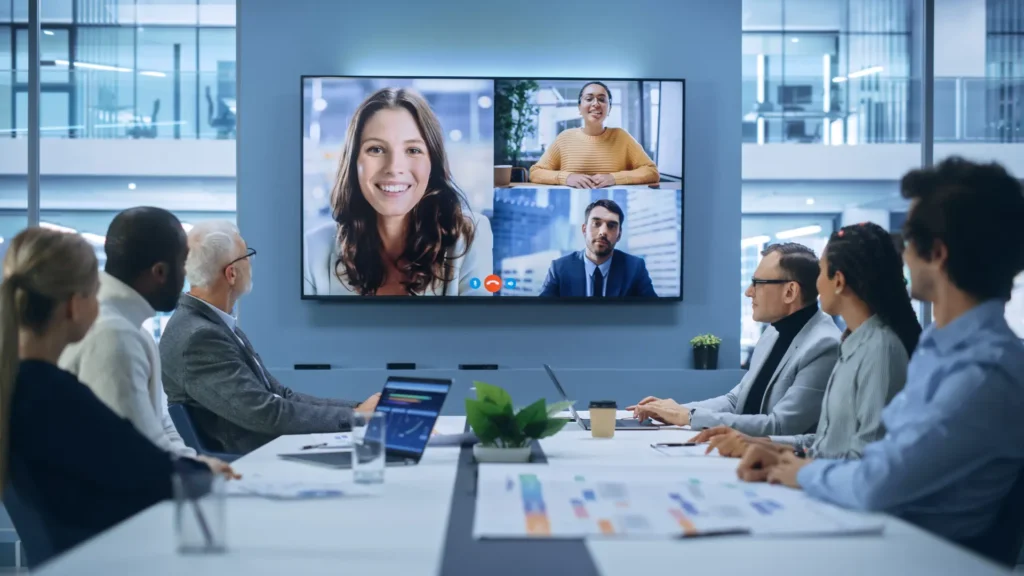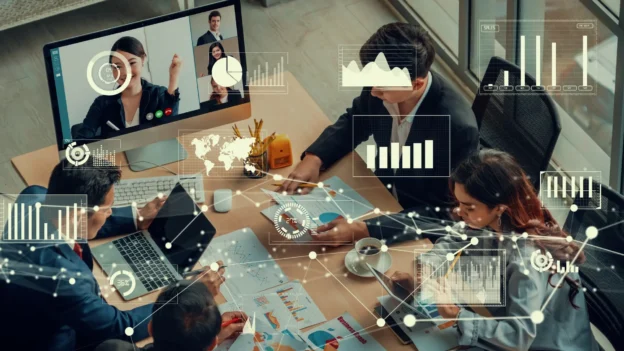Remote audits are assessments of management systems, processes, or suppliers that are carried out remotely using information and communication technologies, without the auditor being physically present in the organization. Their purpose is to verify compliance with requirements in an efficient, secure, and reliable manner.
In recent years, accelerated digitization and globalization have prompted companies to seek new ways to evaluate their performance and ensure quality. Based on the above, Remote Audits are positioned as part of the future of management, endorsed by international regulatory frameworks such as ISO 19011, which establishes guidelines for auditing management systems, and IAF MD 4, a mandatory document of the International Accreditation Forum (IAF), which regulates the use of technologies in audits.
What is a remote audit?
A remote audit is a systematic evaluation process in which the auditor and the auditee connect via digital means, such as videoconferencing, collaborative platforms, cloud systems, or secure information exchange tools. Its purpose is the same as in a traditional audit: to verify compliance with established requirements and build confidence in the results.

Unlike in-person audits, in which the auditor physically tours the organization’s facilities, remote audits leverage information and communication technologies (ICT) to observe processes in real time, interview staff, analyze documents, and review objective evidence without the need to be on site.
There are different types of audits that can be performed under this approach:
- Management system audits (quality, environment, safety, among others).
- Supplier audits, especially useful when managing global supply chains.
- Regulatory compliance audits, in sectors such as pharmaceuticals or energy.
- Internal audits, carried out by the organizations themselves to monitor their processes and prepare for certifications.
In essence, remote audits are a natural evolution in the world of management, combining the methodological rigor of international standards with the flexibility and efficiency provided by technology. These audits are an excellent mechanism for evaluating management systems, as shown in the following video. Courtesy of: OSH dynamic.

Remote audits of management systems.
Benefits and challenges of remote audits
Remote audits have established themselves as a powerful tool for evaluating management processes and systems in an interconnected world. Their use brings multiple benefits, but also poses certain challenges that organizations must manage strategically.
Benefits of remote audits
- Cost reduction: eliminates travel, accommodation, and logistics expenses associated with on-site audits.
- Global access: allows for immediate auditing of suppliers, subsidiaries, or projects located in different regions of the world.
- Time efficiency: streamlines the planning and execution of audits, with greater flexibility in scheduling activities.
- Business continuity: enables certification and control processes to be maintained even in contexts of crisis or mobility restrictions.
- Lower environmental footprint: contributes to sustainability by reducing travel and consumption of physical resources.
Challenges of remote audits
- Cybersecurity and confidentiality: the exchange of digital information requires high standards of protection and access control.
- Reliability of information: physical absence can make it difficult to directly verify certain evidence or conditions on site.
- Technological dependence: stable connectivity, adequate equipment, and secure platforms are required to ensure a smooth process.
- Cultural resistance: some teams and auditors still show distrust toward this approach, perceiving it as less rigorous than the in-person approach.
Table: Comparison: Benefits vs. Challenges
| Benefits | Challenges |
|---|---|
| Reduction of operational costs | Need for robust cybersecurity |
| Greater efficiency and flexibility | Limited field verification |
| Global and scalable reach | Dependence on technology |
| Sustainability (lower CO₂ footprint) | Resistance to cultural change |
Best practices for remote audits and ISO 19011
The application of remote audits is not an improvised process. To ensure their credibility and effectiveness, it is necessary to rely on international regulatory frameworks that establish clear guidelines. Two of the most relevant documents are ISO 19011:2018, a guide for auditing management systems, and IAF MD 4:2018, a mandatory document from the International Accreditation Forum (IAF) on the use of technologies in audits.
ISO 19011: Guidelines for auditing management systems
The ISO 19011 standard establishes the basic principles that should govern all audits: integrity, impartiality, fair presentation of findings, and due professional care, among others. In the context of remote audits, it emphasizes the importance of:
- Assess the feasibility of the remote approach considering the audit objectives.
- Ensure that auditors are competent not only in audit techniques but also in the use of digital technologies.
- Ensure that remote methods are equivalent in reliability to face-to-face methods.
- Adapt the planning and execution of the audit to manage risks arising from the use of ICT.
IAF MD 4: Use of ICT in Audits
IAF MD 4 complements ISO 19011 by establishing mandatory guidelines for certification bodies that use technology in their audits. This document clarifies:
- The use of tools such as videoconferencing, mobile cameras, drones, or cloud data sharing is permitted, provided that reliability is ensured.
- The auditing body must assess the risks and limitations of the remote approach in advance.
- The confidentiality and security of information must be protected through agreements, access protocols, and secure platforms.
- Not all activities can be done remotely: in some critical cases, an on-site visit is still necessary.
Key best practices for remote audits
- Assess risks before deciding on a remote approach: identify which processes can be audited digitally and which require physical presence.
- Train the audit team in the use of technology platforms and cybersecurity.
- Define clear communication protocols with the auditee to avoid interruptions or misunderstandings.
- Test the technology tools in advance to ensure they are working properly on the day of the audit.
- Document the entire process with the same rigor as an in-person audit, ensuring traceability and objective evidence.
Industries that use remote audits
Remote audits are no longer a passing trend; they have become an established practice in sectors where safety, quality, and business continuity are critical factors. Thanks to technology, it is possible to evaluate complex processes and ensure regulatory compliance even in globalized contexts.
- Pharmaceutical industry: In a highly regulated sector, where process validation and compliance with Good Manufacturing Practices (GMP) are mandatory, remote audits have made it possible to verify documentation, interview staff, and observe procedures in real time without disrupting sensitive operations. This ensures continuity in certifications and confidence in product safety.
- Energy and oil: Energy, oil & gas, and power generation companies often operate plants in remote or hard-to-reach locations. Remote audits facilitate the review of quality, safety, and environmental management systems, reducing logistical and safety risks associated with travel, while enabling constant monitoring of critical operations.
- Supply chain and global manufacturing: In increasingly extensive and diversified supply chains, remote audits have proven essential for verifying international suppliers. Through the use of collaborative platforms, blockchain, and videoconferencing, organizations can ensure traceability, contract compliance, and risk assessment without the need for on-site visits.
- Other expanding sectors: These include the following.
- Financial services: verification of regulatory compliance and cybersecurity.
- Food and beverages: assurance of food safety standards in globally distributed plants.
- Education and health: accreditation and control of quality standards in institutions with locations in multiple countries.
The future of remote audits with emerging technologies
Remote audits have evolved from being a contingency solution to becoming a strategic practice. Their future is closely linked to the integration of emerging technologies, which enable more reliable, accurate, and secure audits.
- Artificial Intelligence (AI): AI will transform the way data is analyzed in audits. With machine learning algorithms, auditors will be able to detect patterns of non-compliance, predict risks, and automate document reviews. This will not only reduce analysis time, but also enable audits that are more preventive than corrective.
- Blockchain: Transparency and traceability are key in regulated sectors. Through blockchain, it will be possible to guarantee that the audited information has not been altered, providing confidence in critical records such as supply chains, drug traceability, or environmental certifications.
- Internet of Things (IoT): The IoT will facilitate the connection of devices in the plant with audit systems. Connected sensors and equipment will allow auditors to monitor critical variables such as temperature, pressure, emissions, or energy consumption in real time, strengthening continuous verification.
- Augmented reality (AR) and virtual reality (VR): These technologies will take the auditing experience to a new level. With smart glasses, an auditor will be able to “be present” in an industrial plant, guiding tours, requesting visual verifications, or even simulating risk scenarios to validate staff responses.
- Cybersecurity and digital trust: As remote audits become more widespread, information protection will be a central pillar. Advanced encryption technologies and secure digital environments will be indispensable to ensure the confidentiality and integrity of data shared between auditors and auditees.
Conclusions
Remote audits have proven to be a strategic tool for organizations seeking efficiency, global coverage, and continuity in their management processes. Their success depends not only on the technology used, but also on planning, auditor competence, and the commitment of the audited teams.
The use of international standards such as ISO 19011 and IAF MD 4 ensures that remote audits meet reliability, security, and traceability standards, strengthening the credibility of the results. In addition, the integration of emerging technologies such as AI, blockchain, IoT, and augmented reality expands the capacity for verification and risk anticipation, taking audits to a more intelligent and strategic level.
In the future, remote audits will not completely replace face-to-face audits, but will coexist in hybrid models, allowing organizations to optimize resources, improve the quality of their processes, and remain competitive in a globalized environment. Adopting them in a conscious and planned manner will be key to transforming quality management into a strategic and sustainable asset.
References
- International Accreditation Forum. (2018). IAF Mandatory Document for the Use of Information and Communication Technology (ICT) in the Audit Process (IAF MD 4:2018).
- International Organization for Standardization. (2018). ISO 19011:2018 Guidelines for auditing management systems. ISO.
- Kumar, S., & Rani, P. (2021). Remote auditing in quality management systems: Trends, challenges and future perspectives. Journal of Quality in Maintenance Engineering, 27(2), 201–218.
- Smith, J., & Brown, L. (2020). Leveraging emerging technologies for effective remote audits. International Journal of Auditing Technology, 12(4), 45–60.
- Taylor, M. (2022). Remote audits in the pharmaceutical and energy sectors: Best practices and lessons learned. Quality Management Review, 19(1), 34–50.
Frequently asked questions (FAQs) about remote audits
Given the novelty of the accelerated application of remote audits in the management of various industrial sectors, it is normal for doubts and concerns to arise that generate questions on the subject. Among the most common are the following:
When can remote audits be used?
Remote audits are ideal when the organization is looking for efficiency, cost savings, or needs to audit processes in multiple locations. They are also useful in situations where mobility is restricted, such as health emergencies, or to monitor international suppliers without traveling to their locations.
What are the pros and cons of remote audits?
Pros: cost savings, flexibility, global access, and lower environmental impact.
Cons: technological dependence, possible limitations in physical verification, need for digital security, and resistance to cultural change within the organization.
Are remote audits accepted by ISO standards?
Yes. ISO 19011 and IAF MD 4 establish guidelines for conducting remote audits in compliance with requirements for reliability, auditor competence, and information protection. Not all activities require physical presence, but some critical evidence may still require on-site visits.
Which technologies are most effective for remote audits?
The most commonly used include videoconferencing, secure collaborative platforms, cloud systems, IoT sensors, augmented reality (AR/VR), and blockchain for traceability. The choice depends on the type of audit, the level of complexity of the processes, and regulatory requirements.
Will remote audits replace in-person audits?
Not completely. Remote audits complement in-person audits and are integrated into hybrid models. Their goal is to maximize efficiency, coverage, and security, while physical visits remain necessary in critical cases where direct verification is essential.

